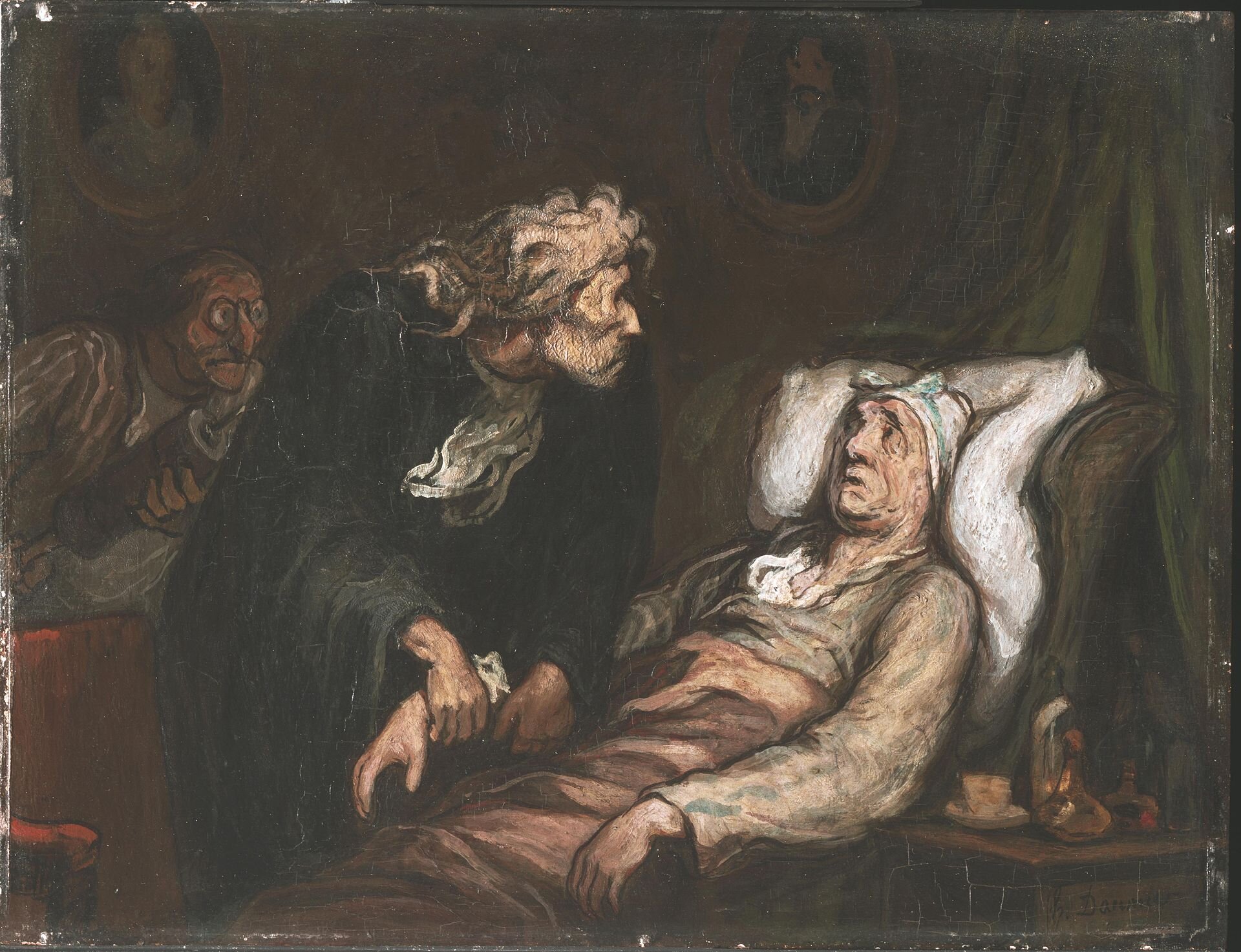Rx 47 / The Hypochondriac
When a physician speaks to you of aiding, assisting, and supporting nature … he just tells you the romance of physic. But when you come to the truth and experience, you find nothing of all this; and it is like those beautiful dreams, which, on awaking, leave you nothing but the regret of having believed in them.
— molière, The Imaginary Invalid
In this chiaroscuro scene, popular caricaturist Honoré Daumier (1808–1879) transforms French playwright Molière’s popular play The Imaginary Invalid (1673) into a severe representation of the doctor-patient relationship. Most striking is the dramatic contrast of light and darkness. The two figures are illuminated against the shadowy background, and contextual details are sparse aside from a small side table to the right with bowls, a spoon, and bottle. Light contours discrete areas of the physician’s head, jabot, and hands. His dark cloak disappears into the black interior of the room. Wispy, translucent brushstrokes lend a ghostly pallor to the patient, Argan. Hand limp in the physician’s firm grasp, Argan’s listless head drops back onto the chair with mouth agape and hollow eyes falling into shadows. The overall effect is stark and almost hallucinatory; we have been offered an eye into the terror of the hypochondriac, who appears unwell or even dead but who we know, from the painting’s title, is only imagining his ailment.
The Hypochondriac is paired with another Daumier work, Two Drinkers, within the main gallery ensemble at the Barnes. Two Drinkers evokes a similar stylistic composition— an emphasis on design at the expense of context. This work shows a pair of hard-bitten men stooped over a small table in shadow. Both paintings are suspended in ambiguity; a brief moment of intense interaction. Deep space engulfs the individuals in the pair of paintings, and the artist infuses the canvas with somber colors, dramatic highlights, and dark contrasts. Like The Hypochondriac, Two Drinkers explores the dynamic of a relationship once all else is stripped away.
An astute observer of the world around him, Honoré Daumier was a nineteenth-century French painter and satirist who created thousands of works targeting corruption, unfair taxation, and pretension. His oeuvre became synonymous with humorous, biting commentary of Parisian bourgeois, the justice and education systems, and race and gender roles. Other depictions of the hypochondriac—a subject to which Daumier turned to repeatedly—are more aligned with the artist’s satirical reputation. In a work housed at the Philadelphia Museum of Art, for example, the physician and patient are more clearly defined as caricatures and an assistant carries a comically oversized enema. Unlike these comedic iterations that imply feigned symptoms, this harrowing version of The Hypochondriac is seen from the perspective of the patient. The viewers are spectators to the performativity of disease and illnesses unseen.
Honoré Daumier, The Imaginary Illness, c. 1860-1862. Philadelphia Museum of Art.
reflections…
In the Barnes version of The Hypochondriac, Daumier captures a moment in French medicine, during the second half of the seventeenth century, when many physicians relied on bloodletting and purging to recalibrate the humors. Even without this historical context, Daumier’s composition conveys an intensity between the two figures with daunting obscurity. Hung on the East Wall of the Main Gallery at the Barnes alongside Rembrandt and Cezanne, The Hypochondriac occupies a central position in the collection of Dr. Albert Barnes, himself a physician. Here, the viewers inhabit the patient’s fearful state as Daumier obfuscates the mind and the body, the fictitious and the real.
Is the piece comedic and absurd, or does it portray affliction and pain? Do we empathize with or fetishize the patient’s distress? Does the ambiguity of the work limit its capacity to be cathartic? What happens to caregiving and the search for meaning absent catharsis? Does ambiguity around the state of one’s health similarly prevent catharsis? When do we in modern medicine tend to be dismissive of a patient’s physical suffering (i.e., “the worried well”) and deem it psychological, distorted, or even a farce? How can we learn to put hubris aside and acknowledge a patient’s lived experience and perceived vulnerabilities as real, irrespective of etiology?
Daumier establishes relationality between the doctor and patient in both versions of this scene. Whereas the Philadelphia Museum of Art caricature emphasizes an imbalance between the hovering doctor and subordinate patient, the Barnes painting enshrouds both figures in darkness. How has the COVID-19 pandemic similarly plunged doctors and patients into a shared state of constant anxiety and ambiguity? Especially in the early days of the pandemic, neither party knew whether they were subject to a novel and terrifying illness; both felt a heightened sense of precarity and fear of contagion, which at times erased any power differential and may have generated a sense of togetherness. How might The Hypochondriac help us to reflect on and acknowledge fears of uncertainty and loss of control as shared experiences in this moment? Similarly, how might it convey anxiety about the health or lack thereof of the body politic as we emerge from the pandemic? What can we do beyond this moment to retain a sense of empathetic mutuality in the clinical encounter?
sources
The Barnes Foundation, “Honoré Daumier, The Hypochondriac (Le Malade imaginaire),” https://collection.barnesfoundation.org/objects/6987/The-Hypochondriac-(Le-Malade-imaginaire)/.
The Barnes Foundation, “Honoré Daumier, Two Drinkers (Les Deux buveurs),” https://collection.barnesfoundation.org/objects/6983/Two-Drinkers-(Les-Deux-buveurs)/.
Philadelphia Museum of Art, “Honoré Daumier, The Imaginary Illness,” https://www.philamuseum.org/collection/object/54450.










